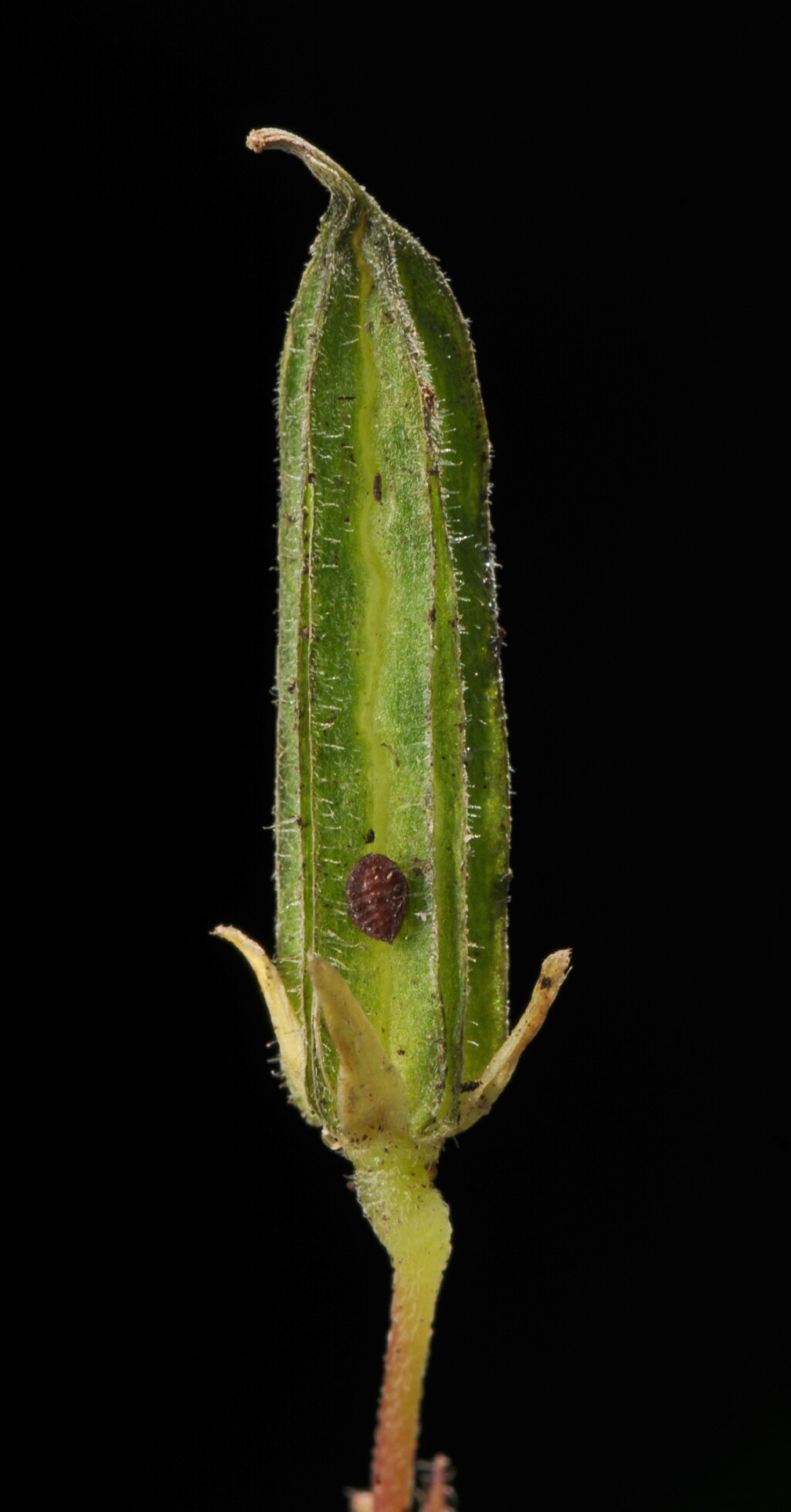Oxalis corniculata
L. Yellow Wood-sorrelAnnual or sometimes perennial herb with stems erect or ascending, sometimes creeping, to 30 cm long, stems often freely rooting at nodes, sparsely to densely covered with spreading and or retrorse hairs, or nearly glabrous with antrorse appressed or slightly ascending simple hairs, green, glaucescent, or bronze-purple to maroon; taproot sometimes present; bulbils absent. Leaves cauline, alternate, 3-foliolate; leaflets subsessile, obcordate, 4–13(–20) mm long, 4–22(–25) mm wide, bilobed, green or bronze-purple to maroon, glabrous above, sparsely pubescent below, margins ciliate, sinus to c. two-fifths leaflet length, lobes obovate, apices rounded, 3–15 mm apart; petioles (0.5–)1–7 cm long, with mostly spreading hairs; stipules usually conspicuous, to 2–3 mm long, apex more or less truncate, ciliate; calli absent. Inflorescences axillary, flowers 1–5(–6) per peduncle in irregular or umbelliform cymes, usually held below or at leaf level, less often a little above leaf level; peduncles not usually longer than leaves, antrorse-hairy; pedicels deflexed in fruit (but capsules erect). Sepals lanceolate, 3–4 mm long, often ciliate; calli absent. Petals 6–7 mm long, yellow, throat with or without faint to conspicuous red streaks. Filaments glabrous. Styles short. Capsule cylindrical, (8–)10–18(–20) mm long, 1–3 mm diam., usually densely retrorse-hairy with simple hairs, very rarely also with longer septate hairs, or rarely glabrescent with microscopic simple hairs; seeds 1.0–1.5(–1.7) mm long, transversely ribbed, ribs 6–9 (often broken), usually narrow, grooves usually wide and deep, uniformly reddish brown, dull, or ribs occasionally with faint greyish or prominent white lines or blotches. Flowers Sep.–Apr.
LoM, MuM, Wim, GleP, Brid, VVP, VRiv, MSB, RobP, MuF, GipP, OtP, WaP, Gold, CVU, GGr, DunT, NIS, EGL, EGU, WPro, HSF, HNF, OtR, Strz, MonT, HFE, VAlp. Oxalis corniculata is a cosmopolitan species with an unknown origin. Groom et al. (2019) argue that the most likely origin for O. corniculata is south–east Asia.
Oxalis corniculata is a very variable species. Many infraspecific taxa of O. corniculata have been described over its cosmopolitan range, but their taxonomic status is uncertain. A form known mainly from urban gardens in Melbourne (Heathmont, Malvern East, South Yarra) is included here with reservation as a 'form' of O. corniculata, but may in fact be another species. It has nearly glabrous stems which do not root at nodes or do so only proximally, stems with scattered antrorsely appressed hairs, and the seed ridges with prominent white lines and/or blotches. This entity is possibly also annual or mostly annual. Other than a form of O. exilis (see notes for that species), that often occurs in lawns and disturbed sites, no other members of the O. corniculata group in Australia have been observed with distinct white lines and/or bloches on the seed ridges. Occasional specimens of O. corniculata have faint greyish lines (faint greyish lines or blotches sometimes present in O. chnoodes), but the stem indumentum is moderately to densely hairy and spreading. Several members of the O. corniculata complex in North America, including O. albicans, O. californica, O. macrantha and O. texana, have white lines and/or blotches on the seed ridges, but the Victorian plants cannot be matched with any of these species. Another distinctive entity known from two collections from urban gardens in Melbourne (Forest Hill, and South Yarra) is characterised by having a very dense stem indumentum of spreading and retrorse hairs, and inconspicuous stipules with very narrow free margins. It's possible that this entity might represent O. pilosa, a species from North America, but is here also treated with reservation as part of O. corniculata, pending resolution of its identity.
Oxalis corniculata also has different anthocyanin variants, of which there may be at least two in Victoria. O. corniculata var. atropurpurea is sometimes applied to plants with all vegetative parts that are red, but this character appears to be variable, and given the uncertainty in the application of the name, the name is not used here. It is unclear whether O. corniculata var. atropurpurea truly differs from O. corniculata var. corniculata other than in the colour of vegetative parts. The anthocyanin form can grow together with plants exhibiting the typical expression, and it is unclear whether this represents intrapopulational variation, or whether the forms are reproductively isolated. Nair & Kurichian (2004) have found that in Malaysian plants of O. corniculata var. atropurpurea that there are differences in karyotype, in floral and vegetative morphology, and post-pollination reproductive barriers, which suggests that at least in Malaysia that O. corniculata var. atropurpurea merits consideration for specific rank.
 Spinning
SpinningEiten, G. (1963). Taxonomy and regional variation of Oxalis section Corniculatae. I. Introduction, keys, and synopsis of the species. The American Midland Naturalist 69(2): 257–309.
Groom, Q. J.; Van der Straaten, J.; Hoste, J. (2019). The origin of Oxalis corniculata L.. PeerJ 7.
Nair, B. R; Kurichian, P. (2004). Cytogenetic evidence of the evolution of Oxalis corniculata var. atropurpurea. Cytologia 69: 149–153.
Nesom, G.L. (2009). Again: Taxonomy of yellow-flowered caulescent Oxalis (Oxalidaceae) in eastern North America. Journal of the Botanical Research Institute of Texas.
Nesom, G.L. (2009). Notes on Oxalis Sect. Corniculatae (Oxalidaceae) in the southwestern United States. Phytologia 91(3): 527–533.
Nesom, G.L. (2014). Further observations of the Oxalis dillenii group (Oxalidaceae). Phytoneuron 12: 1–10.
Sykes, W.R. (2009). The Oxalis corniculata group. New Zealand Journal of Botany 47: 107–113.





